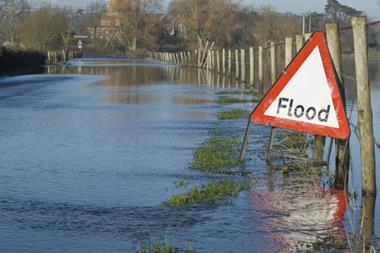Firms are struggling to access affordable flood coverage as the impact of climate change becomes more apparent
Last year saw record rainfall and catastrophic flooding across the globe as extreme weather events continue to become more commonplace.
For example, the World Meteorological Organisation reported in October 2021 that western Germany and eastern Belgium received 100mm to 150 mm on 14 and 15 July over already saturated ground, causing flooding and landslides that led to more than 200 deaths. The highest daily rainfall was 162.4 mm at Wipperfürth-Gardenau.
How UK flood is changing
November 2021 saw Storm Arwen cause a million power outages in the UK, with economic and insured losses from the event expected to reach into the tens of millions of pounds, according to an Impact Forecasting report published in December 2021.
A report on the UK’s climate risk, published by independent statutory body the Climate Change Committee in June 2021, recognised that the country’s climate is getting warmer and wetter.
So, the UK will subsequently face increasing rainfall intensity and continued sea level rises, while at the same time, more homes will inevitably be built on flood plains. As climate change exacerbates UK flood events, this may mean that some properties, or businesses, become uninsurable.
“There are indications that overall, we’re looking at an increase in precipitation in the UK under a changing climate,” said Joss Matthewman, director of climate change, product management and strategy at Risk Management Solutions (RMS).
“The insurance industry has a history of innovation. We know that risks have emerged over time and that the industry has been able to innovate and bring solutions to tackle these.”
Spreading the cost
Despite the changing climate, UK homes will continue to be insurable for the foreseeable future. This is because joint government and industry reinsurance scheme Flood Re provides a mechanism to ensure flood cover is available until at least 2039.
Between now and then, Flood Re - on behalf of its members - has an objective to increase individual flood resilience, particularly for those in high flood risk areas.
However, Flood Re does not cover business properties.
So, although there is now more awareness in the planning process for flood-risk areas and the construction industry is building more homes and commercial properties in a flood-resilient manner, issues with existing stock remains.
Bev Adams, consulting director and head of climate and catastrophe resilience at broker Marsh, said: “The truth is that we have a lot of building stock already [as well as] a lot more rainfall and that makes things tricky.
“When you think about the infrastructure built in our country, that has to take action and become more resilient too. There’s a lot of elements to how we adapt to a warmer world.
“There’s an awful lot of work being done to manage the future, whether that’s at the planning level, the insurance level, whether it’s how we develop scoring.”
Adams explained that because Flood Re does not cover commercial properties, when a business has got a flood risk, the onus is very much on the company itself to work with brokers and insurers to find the right way to manage it.
Lack of affordable cover
She continued: “Part of that might be financially, but part of it might be operationally. It’s that balancing of the operational and financial risk that we sit in the middle of.
“We are getting more enquiries because businesses are struggling to get affordable flood cover, or their terms are changing.”
Despite the extra challenges facing flood-prone commercial policyholders, Adams added that it is not “all doom and gloom”, however.
“When we get together and figure out the resilience that we can put in place together, generally we reach a happy landing,” she explained. “That might involve putting in place innovative insurances, like parametric [policies].”
It is also imperative that businesses which have flood risks create a flood emergency response plan.
Adams concluded: “Otherwise flooding will happen and you will be on the back foot and you won’t know what to do about it. We’ve seen so many cases where training, monitoring and being ready is a massive differentiator.”




















No comments yet